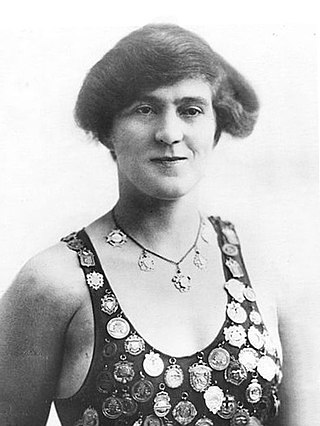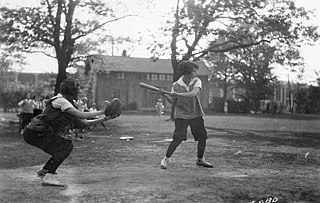
Gertrude Caroline Ederle was an American competition swimmer, Olympic champion, and world record-holder in five events. On August 6, 1926, she became the first woman to swim across the English Channel. Among other nicknames, the press sometimes called her "Queen of the Waves".

The Amateur Athletic Union (AAU) is an amateur sports organization based in the United States. A multi-sport organization, the AAU is dedicated exclusively to the promotion and development of amateur sports and physical fitness programs. It has more than 900,000 members nationwide, including more than 100,000 volunteers. The philosophy of the AAU is "Sports for All, Forever."

Kristin Otto is a former German swimmer, becoming Olympic, World and European champion, multiple times. She is most famous for being the first woman to win six gold medals at a single Olympic Games, doing so at the 1988 Seoul Olympic Games. In long course, she held the world records in the 100 meter and 200 meter freestyle events. Otto was also the first woman to swim the short course 100 meter backstroke in under a minute, doing so at an international short course meet at Indiana University in 1983.

Summer Sanders is an American sports commentator, reporter, television personality, actress, former competition swimmer and Olympic champion from 1992.

Annette Marie Sarah Kellermann was an Australian professional swimmer, vaudeville star, film actress, and writer, usually known as Annette Kellerman.

Sarah Frances "Fanny" Durack, also known by her married name Fanny Gately, was an Australian competition swimmer. From 1910 until 1918 she was the world's greatest female swimmer across all distances from freestyle sprints to the mile marathon.

Donna de Varona Pinto is an American former swimmer, Olympic champion, activist, and television sportscaster.

Isabelle Mary White was the first British diver to win a medal at the Olympic Games, and the first to win a European championship. She competed in four Olympics, including the 1912 Summer Olympics, where she won a bronze medal in the women's plain high diving event, as well as the 1920 Summer Olympics, 1924 Summer Olympics, and 1928 Summer Olympics. She also won a gold medal at the European Aquatics Championships in 1927.

Katherine Louise Rawls, also known by her married names Katherine Thompson and Katherine Green, was an American competition swimmer and diver. She was the United States national champion in multiple events during the 1930s.

Thelma R. Payne was an American diver who won the bronze medal in the 3 meter springboard at the 1920 Summer Olympics. She also won the springboard at the AAU Championships in 1918–1920. Payne was AAU national champion in diving in 1918, 1919 and 1920.

Women have a long history in American baseball and many women's teams have existed over the years. Baseball was played at women's colleges in New York and New England as early as the mid-nineteenth century; teams were formed at Vassar College, Smith College, Wellesley College, and Mount Holyoke College. An African American women's team, the Philadelphia Dolly Vardens, was formed in 1867.

Margaret Ives Abbott was an American amateur golfer. She was the first American woman to win an Olympic event: the women's golf tournament at the 1900 Summer Olympics.
While not being urged to avoid competition, women had few opportunities to compete in sport in Australia until the 1880s. After that date, new sporting facilities were being built around the country and many new sport clubs were created. For swimming, the rapid expansion of facilities took place during the 1880s and the 1890s. Compared to the past when the whole of the swimming community was made up of males, currently 55 percent of the Australian swimming membership is made up of women. Not only do females dominate swimming in the pool but there are more than 5,500 female coaches in the swimming world in Australian and over 2,000 female technical officials.

Elizabeth Anne Esther "Liz" Ferris was a British diver. She was the third of four children to Roy Ferris, a dairyman and Dorothy Philomena. Raised in central London, she attended Francis Holland School and was a member of the Mermaids Swimming Club which was notable for training female athletes for the Olympics. Ferris won a bronze Olympic medal in the women's 3 metre springboard event at the 1960 Rome Summer Olympics.

Undine is a 1916 American silent fantasy drama film which featured the athletic actress Ida Schnall in a water-themed story based upon the fairy tale Undine by Friedrich de la Motte Fouque. The film was directed by Henry Otto and produced and distributed by the Bluebird Photoplays division of Universal Film Manufacturing Company. It is not known whether the film currently survives.
This is a timeline of women's sports, spanning from ancient history up to the 21st century. It includes both competitive sports and notable physical feats.
The participation of transgender people in competitive sports, a traditionally sex-segregated institution, is a controversial issue, particularly the inclusion of transgender women and girls in women's sports.
Justine Siegal is an American baseball coach, sports educator and the founder of Baseball For All. In 2009, she became the first female coach of a professional men's baseball team, when she worked for the Brockton Rox, in the independent Canadian American Association of Professional Baseball. In 2011, she became the first woman to throw batting practice to an MLB team, the Cleveland Indians during spring training. In 2015, hired by the Oakland Athletics for a two-week coaching stint in their instructional league in Arizona, she became the first female coach employed by an MLB team. She has also thrown batting practice to the Tampa Bay Rays, St. Louis Cardinals, Houston Astros, and New York Mets.

Lia Catherine Thomas is an American swimmer. She was the first openly transgender athlete to win an NCAA Division I national championship, having won the women's 500-yard freestyle event in 2022, before being barred from competing in women's events by World Aquatics. Thomas' career has been a part of the public debate about transgender women in women's sports.

Riley Marie Gaines, also known as Riley Gaines Barker, is an American former competitive swimmer, political activist and a 12-time NCAA All-American who competed for the University of Kentucky NCAA swim team. She was the 2022 Southeastern Conference Women's Swimming and Diving Scholar-Athlete of the Year. Gaines has campaigned against the participation of trans women in women's sports.


















